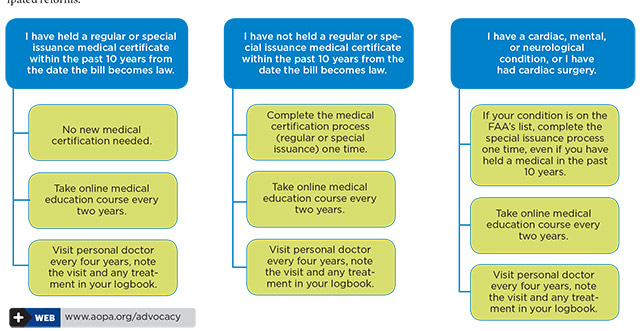
Why the changes in the bill’s language? The original language did not have enough support in the Senate. It was not going to pass or move forward in its original form.
What if I will only support the original language? Accepting only the original language would mean failure of the entire bill. We would end up with nothing—the same way previous efforts have ended.
Will this affect me if I still want to fly as a sport pilot? You may still fly Light Sport-eligible aircraft with at least a sport pilot certificate and a valid driver’s license.
Isn’t this just a move to a 10-year renewal of a medical? No. If you are a private pilot and have a valid medical certificate (regular or special issuance) within 10 years from the date when the bill is signed into law, you may never have to visit an AME again.
What is the online aeromedical course, and who will administer it? The course, taken every two years, would be a requirement to keep flying privileges. The course will be run and maintained through the GA community’s communications channels, such as the AOPA Air Safety Institute. The FAA would only approve the content of the online course.
I feel fine. Why do I have to go to a doctor every four years to prove it? This legislation eliminates the cost, paperwork, and extra hassle of regularly seeing a different doctor just to fly.
What about new private pilots? An initial medical approval by the FAA will ensure that a new pilot in good health can fly. That’s a one-time approval, compared to the biennial medical exam that is now required for pilots older than 40.
Will I be able to get insurance if I fly under the rules set out in the PBR2? Contact your insurance broker or company and ask how they will handle anticipated reforms.
Baker on the move
LAST MONTH
November 9—High School Leadership Alliance, Lakeland, Florida
November 10—AOPA Board of Trustees, Washington, D.C.
November 12—RTCA meeting, Washington, D.C.
November 17-19—National Business Aviation Association, Las Vegas, Nevada
THIS MONTH
December 9—University of North Dakota
“We’re committed to winning third class medical reform, and we’ve come closer to getting it done in 2015 than ever before. We will keep pushing for change until we get it.”
Action in the states
Alaska Region
AOPA is working with the Alaska Flight Service stations, National Weather Service, and the NTSB to increase the number of pilot weather reports (pireps) available in Alaska. The state has the lowest density of aviation weather reporting stations in the country. AOPA Alaska Regional Manager Tom George serves on a working group with industry and government stakeholders to dig into different aspects of the pirep system and ensure the reports filed are making it to pilots.
Northwest Mountain Region
The National Association of State Aviation Officials’ annual conference was held in Boise, Idaho; followed by the Oregon Airport Management Association Conference in Corvallis; and the Utah Airport Operators Association in Bryce Canyon. In Vancouver, Washington, AOPA supports a plan to change the airspace over Pearson Field from Class D to Class E. Hot Springs County-Thermopolis Municipal Airport in Wyoming is opening its newly relocated airport.
Western Pacific Region
Nevada will host a conference on integrating drones into the National Airspace System, December 8-10 in Las Vegas. California’s San Diego Air and Space Museum is scheduled to induct nine individuals into its Hall of Fame, including Alan Mulally for his contributions at Boeing; Frederick Trapnell, the first U.S. Navy pilot to fly a jet; and Rep. Sam Johnson (R-Texas), who flew combat missions in the Korean and Vietnam wars. The museum will honor EAA and the EAA Young Eagles program.
Central Southwest Region
AOPA Airport Support Network volunteer Mike Racine used the opening of a new crosswind runway at Alexander Municipal Airport in Belen, New Mexico, to support Angel Flight, organizing a raffle for the honor of being the first to take off from the new runway. Pilots in Hammond, Louisiana, are forming a flying club. More than a dozen pilots have expressed interest. AOPA President Mark Baker spoke at the Four States Airport Conference in Missouri in October.
Great Lakes Region
AOPA is working with pilots and airport advocates who want to get public-use status for the now private-use-only Batesville Airport in Indiana. During a visit to Columbus, Ohio, AOPA participated in aviation and aerospace day at the statehouse. EAA Chapter 77 in Flushing, Michigan, got an update from AOPA on key local issues. Runway modifications are planned at Winona Municipal Airport-Max Conrad Field in Minnesota. AOPA pointed out the importance of maintaining the field’s two-runway configuration.
Southern Region
Pilots from across the Southeast have donated their time, money, and aircraft to provide relief to those affected by severe flooding in South Carolina. AERObridge delivered more than three tons of food and water to flood victims. AOPA donated $5,000 to AERObridge to help purchase supplies, including food and water. AOPA also donated $5,000 to Florida-based Tropic Ocean Airways to purchase supplies for its relief flights to the Bahamas.
Eastern Region
AOPA President Mark Baker and Eastern Regional Manager Sean Collins spoke at the Massachusetts Airport Management Association Annual Conference. In Maryland, AOPA participated in a meeting of the Maryland Airport Managers Association. At Connecticut’s Tweed New Haven Airport, Collins met with AOPA ASN volunteer Charlie Skelton. At the Rhode Island Airport Corporation’s GA Advisory Group, AOPA listened to Rhode Island airport officials discuss concerns and opportunities for the state’s GA airports.


